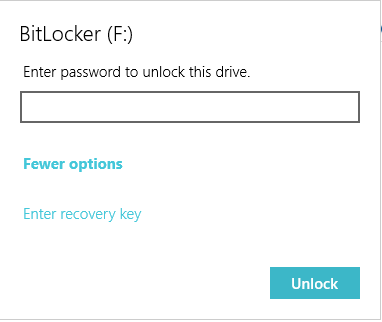

- #Bitlocker download windows 8.1 how to#
- #Bitlocker download windows 8.1 upgrade#
- #Bitlocker download windows 8.1 pro#
- #Bitlocker download windows 8.1 Pc#
- #Bitlocker download windows 8.1 windows 8#
So, with that out of the way, let’s go over how this actually works. If you end up unlocking an encrypted drive on Windows XP or Vista, you’ll see the BitLocker to Go branding, so we figured you should at least know about it.

Windows handles things behind the scenes, and the interface you’ll use to enable BitLocker doesn’t look any different. In Windows 7 through 10, you really don’t have to worry about making the selection yourself. If someone doesn’t have the unlock method, they can’t access the files on the drive. You’ll be prompted for your unlock method-for example, a password-when you connect the drive to your computer. BitLocker To Go: You can encrypt external drives-such as USB flash drives and external hard drives-with BitLocker To Go.You can also encrypt other drives than just the system drive. The encryption is otherwise transparent-your files appear like they normally would on an unencrypted system, but they’re stored on the disk in an encrypted form. BitLocker then decrypts the drive and loads Windows.
#Bitlocker download windows 8.1 Pc#
When your PC boots, the Windows boot loader loads from the System Reserved partition, and the boot loader prompts you for your unlock method-for example, a password.
#Bitlocker download windows 8.1 how to#
RELATED: How to Use BitLocker Without a Trusted Platform Module (TPM)

If you’d like to use a container rather than, say, encrypt your existing system or storage drive, check out our guide to creating an encrypted container file with BitLocker.įor this article, we’re going to concentrate on enabling BitLocker for an existing physical drive. With BitLocker, you create a virtual hard drive, and then encrypt it. In other encryption products, you usually create an encrypted container, and then mount it as a drive in Windows when you need to use it. RELATED: How to Create an Encrypted Container File With BitLocker on Windows That could be your system drive, a different physical drive, or a virtual hard drive (VHD) that exists as a file and is mounted in Windows. BitLocker works by encrypting entire drives. It’s a bit of a misnomer, but you can achieve a similar effect. Many guides out there talk about creating a BitLocker container that works much like the kind of encrypted container you can create with products like TrueCrypt or Veracrypt. Encrypt an Entire Drive or Create an Encrypted Container?
#Bitlocker download windows 8.1 pro#
We recommend Device Encryption if your computer supports it, BitLocker for Pro users who can’t use Device Encryption, and VeraCrypt for people using a Home version of Windows where Device Encryption won’t work. However, starting with Windows 8.1, the Home and Pro editions of Windows include a “Device Encryption” feature (a feature also included in Windows 10) that works similarly.
#Bitlocker download windows 8.1 windows 8#
Note: BitLocker Drive Encryption and BitLocker To Go require a Professional or Enterprise edition of Windows 8 or 10, or the Ultimate version of Windows 7.

#Bitlocker download windows 8.1 upgrade#
RELATED: Should You Upgrade to the Professional Edition of Windows 10? In this article, we’re going to talk about how you can set it up on your PC. BitLocker has been around in Windows long enough to be considered mature, and is an encryption product generally well-regarded by security pros. When TrueCrypt controversially closed up shop, they recommended their users transition away from TrueCrypt to using BitLocker or Veracrypt. BitLocker is a tool built into Windows that lets you encrypt an entire hard drive for enhanced security.


 0 kommentar(er)
0 kommentar(er)
